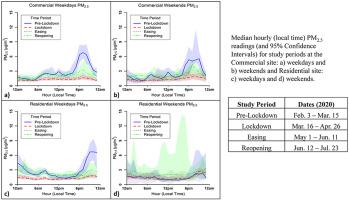Environmental Research ( IF 7.7 ) Pub Date : 2021-06-05 , DOI: 10.1016/j.envres.2021.111471 Daniel L Mendoza 1 , Tabitha M Benney 2 , Ryan Bares 3 , Erik T Crosman 4

|
Urban air quality is a growing concern due a range of social, economic, and health impacts. Since the SARS-CoV-19 pandemic began in 2020, governments have produced a range of non-medical interventions (NMIs) (e.g. lockdowns, stay-at-home orders, mask mandates) to prevent the spread of COVID-19. A co-benefit of NMI implementation has been the measurable improvement in air quality in cities around the world. Using the lockdown policy of the COVID-19 pandemic as a natural experiment, we traced the changing emissions patterns produced under the pandemic in a mid-sized, high-altitude city to isolate the effects of human behavior on air pollution. We tracked air pollution over time periods reflecting the Pre-Lockdown, Lockdown, and Reopening stages, using high quality, research grade sensors in both commercial and residential areas to better understand how each setting may be uniquely impacted by pollution downturn events. Based on this approach, we found the commercial area of the city showed a greater decrease in air pollution than residential areas during the lockdown period, while both areas experienced a similar rebound post lockdown. The easing period following the lockdown did not lead to an immediate rebound in human activity and the air pollution increase associated with reopening, took place nearly two months after the lockdown period ended. We hypothesize that differences in heating needs, travel demands, and commercial activity, are responsible for the corresponding observed changes in the spatial distribution of pollutants over the study period. This research has implications for climate policy, low-carbon energy transitions, and may even impact local policy due to changing patterns in human exposure that could lead to important public health outcomes, if left unaddressed.
中文翻译:

COVID-19 封锁期间城市内细颗粒物的变化:来自犹他州帕克城的案例研究
由于一系列社会、经济和健康影响,城市空气质量越来越受到关注。自 2020 年 SARS-CoV-19 大流行开始以来,各国政府采取了一系列非医疗干预措施 (NMI)(例如封锁、居家令、口罩强制令)来防止 COVID-19 的传播。实施 NMI 的一个共同好处是世界各地城市的空气质量得到了显着改善。我们将 COVID-19 大流行的封锁政策作为一项自然实验,追踪了大流行期间在一个中型高海拔城市中产生的不断变化的排放模式,以隔离人类行为对空气污染的影响。我们跟踪了反映锁定前、锁定和重新开放阶段的时间段内的空气污染情况 研究商业和住宅区的级传感器,以更好地了解每种环境如何受到污染衰退事件的独特影响。基于这种方法,我们发现在封锁期间,城市商业区的空气污染比住宅区减少得更多,而这两个区域在封锁后经历了类似的反弹。封锁后的放松期并未导致人类活动立即反弹,而与重新开放相关的空气污染增加发生在封锁期结束近两个月后。我们假设供暖需求、出行需求和商业活动的差异是造成研究期间观察到的污染物空间分布相应变化的原因。这项研究对气候政策有影响,









































 京公网安备 11010802027423号
京公网安备 11010802027423号